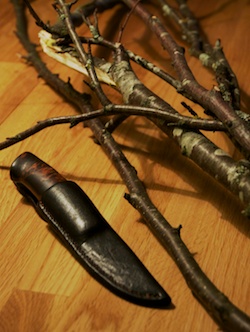
Pinnekjøtt
"Pinnekjøtt" is the second most popular Christmas meal in Norway, and it's what I've had for dinner every Christmas since I was old enough to eat real food. Pinnekjøtt is made from salted and dried ribs of lamb or sheep, and pinnekjøtt is thus most popular on the west coast of Norway, where it's traditionally been very common to have sheep. It is usual to buy pinnekjøtt as a whole side, which you then split into long, narrow pieces by cutting between the ribs. The pinnekjøtt must then be left in cold water for 24 hours to dilute the salt. To cook it, it should be steamed for about three hours, and this is traditionally done by placing sticks of birch in the bottom of the pot, to keep the meat out of the water. The word pinnekjøtt literally means "stick meat" (stick as in a piece of wood), and I've heard two possible explanations for this term, either that each rib looks a bit like a stick, so thus stick meat, or that it refers to the sticks one uses in the steaming, so meat steamed on sticks, shortened to stick meat.
Cooking pinnekjøtt is almost trivially easy, as all you need to do is to put it in a large pot with some sticks, add water, bring to a boil, and then keep it boiling for three hours while making sure it doesn't dry out. The usual sides are also quite straightforward to make. In my family, we have "pølse" (sausages, usually quite coarse and spicy, more similar to British sausages than the normal Norwegian ones), "potet" (potatoes), "kålrabistappe" (stewed (not stued) Swedes), "surkål" (often translated as sauerkraut, but it's not really the same thing, I think. Sauerkraut is supposed to be fermented and all kinds of things, while surkål is basically just cabbage boiled with vinegar. I think.) and "tyttebærsyltetøy" (lingonberry jam).
The only one of these to have real potential for experimentation is the kålrabistappe (unless you want to make the surkål yourself, which I've never tried). You start by peeling, cutting and boiling some Swedes, and when they are fairly soft, you mash them into something of a similar consistency to mashed potatoes. You then add none or more of the following: stock from the pinnekjøtt pan, butter, cream, milk, salt, pepper and nutmeg. And possibly other things. When I made kålrabistappe today, I added all of the above except milk, and it turned out pretty good.

Pinner
Except for the stewed Swedes, all the sides pretty much cook themselves. The sausages you can steam for half an hour or so by adding them to the pinnekjøtt pot, the potatoes are just normal boiled potatoes, and the surkål you can just heat in the bag by dropping them in boiling water. Unless you make the surkål yourself. And now that I think about it, it seems a bit silly not to make it yourself. I think I might actually do that this year. If my father will let me near the kitchen, that is. The Christmas meal is after all an important thing which is supposed to be the same each year, and thus it's not the time or place for creative experimentation. But if I do, a report will follow.
I had some colleagues in the optics group over for a pinnekjøtt-dinner today, including one svineribbe man (svineribbe is the most popular Norwegian Christmas meal, eaten by more than 50% of Norwegians), one fresh-cod man and one Frenchman. I stupidly forgot to write down any quotes for this article, but they all thought it was very good. All in all, I'm very pleased, especially as I've only made pinnekjøtt half a time before, as detailed in this
liveblog from a Christmas dinner from last year (in Norwegian).
-Tor Nordam



Comments